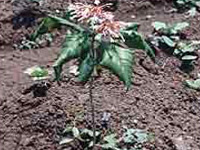Rauvolfia Serpentina
The dried root of Rauvolfia serpentina commonly known as Rauvolfia root, and as Sarpagandha in Sanskrit, is one of the most important crude drugs used in modern medicine.
Cultivation Technique
Land Preparation
The land to be prepared for planting is deep ploughed once in a month of May and allowed to weather. Care should be taken to uproot stubs of trees and clear the area of other forest growth before ploughing. After the premonsoon showers, when the weeds of the season have appeared, farmyard manure or compost at the rate of 30-37 cartloads per hectare may be applied. |

|
Source- Pankaj Oudhia (SOPAM) |
At this stage second ploughing is done followed by two cross harrowings to break the clods. Convenient sized beds with suitable irrigation channels are then laid out.
Propagating Material
The plant is propagated by seeds, stem cutting and root cutting.
Propagation from seed
Before planting, the seeds should be soaked in 5% NaCl solution. The seed floating on the surface should be discarded and those which sink should be selected. The pre-treatment of seeds is done with some fungicide such as ceresin or captan. Before sowing the seeds are soaked in water overnight.
Planting
The soaked seeds are dibbled about 2cm deep in lines 7.5 inches apart. It is estimated that about 5.5 kg seeds sown in 0.05 ha give adequate number of seedlings to plant one hectare.
Propagation by root cutting
The large taproot as well as lateral secondary rootlets are employed for preparing the cutting of 2.5 - 5.0 cm long and generally not exceeding 12.5mm in diameter.
Planting
It is done horizontally in holes 5 cm deep at the advent of the monsoon 100kg root cutting are needed to plant one hectare.
Propagation by root stump
Approximately 5cm of the root with a portion of the stem above the collar is planted in May-June in irrigated fields.
Propagation by stem cutting
Stem cutting 5-7 cm long with 3 internodes are considered ideal. Hard woodcuttings are certainly better than soft woodcuttings. Treating cutting for 12 hrs with B indol acetic acid (30ppm) initiates rooting within a period of 15 days.
Transplanting
The seedlings are transplanted during the monsoon. At this time seedling which have attained a height of 7.5-12 cm are carefully picked up from nursery beds to avoid injury to the long delicate roots. The seedlings are immediately transplanted in rows 60 cm x 30 cm apart. A hole 15-20 cm deep is made with a pointed stock and the seedling is placed in it without bending the main root and the soil is then gently but firmly pressed. The field is irrigated soon after.
Irrigation
At regular intervals the transplanted seedling are irrigated till they establish. Where irrigation facilities exist the plant are irrigated twice a month during hot dry season and once a month during the winter.
Manuring
The use of organic manures leaf mold and compost has been recommended to increase the quality of nutrients in the soil and improve the drainage. Nitrogenous fertilizers induce more vegetative growth effect on the root. It is better to apply a basal dose of 30 kg/ha of k2O and P2O5 and 20kg/ha of N before planting. Two top doses of N should also be applied during the growing season every year.
Weeding
About two weedings are necessary during the monsoon and one hoeing at the end of the growing season in order to maintain satisfactory development of roots.
Harvesting
The duration of crop is one to one and half years. Roots are harvested during the winter months as alkaloidal content is considered to be high during this period. Care is taken to keep the root bark intact as the bark has higher alkaloidal content. It is essential to dry the roots before storage. It is advisable to dry the roots further so as to contain less than 8% moisture to avoid the fungal attack. Under the present system only top roots are selected for processing.
Disease and Pests
R.Serpentina is prone to infection by different groups of fungi as:
Leaf spot - (Cercospora rauvolfiae)contol by spraying Dithane Z-78 or dithane M-45
Target leaf spot - (Corynespora cassiicola) captan sprayed aso-25% solution in water in
early june.
Leaf blotch-(Cercospora serpentinae)
Anthracnose- (Collectorichum gloesporiodes)Dithio cubamertes - fermate, dithane & teriate.
Dieback- (C.dematium)Dithane- m-45(0.2%)
Wilt- (Fusarium oxysporum)
Pest- Caterpillar, Spingid moth, Cockchafer grub, Black bug, Lab lab pod bug, wingless grasshopper, weevil.
Yield
The plant raised from seeds give the maximum yield of roots varying widely from 1 to 4 Kg/plant. The average yield per hectare harvested after 15 months & 36 months has been worked out to be 2000 Kg and 36000 kg respectively.
Economics
Yield/ha |
1000 kg/ha(dry) |
Sale price |
Rs.50/kg |
Expenditure/ha |
Rs.12000 |
Net profit |
Rs.38000 |
|

